OUTSTANDING CRASH PREVENTION THAT IS STANDARD IN THE ALL-NEW XC90
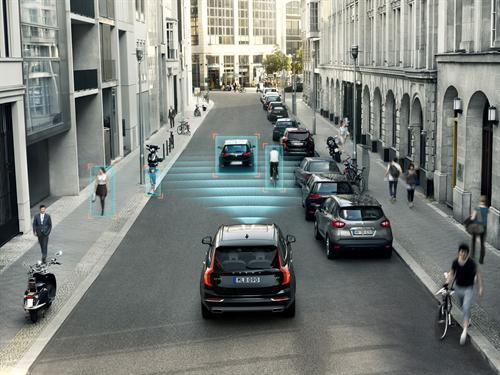
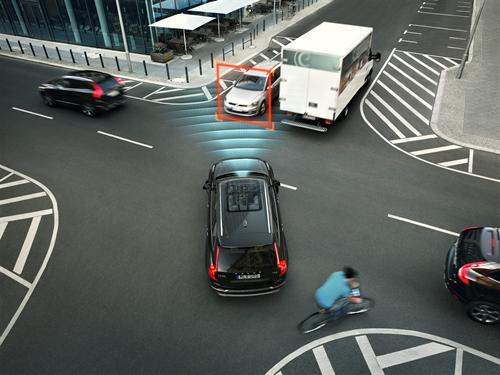
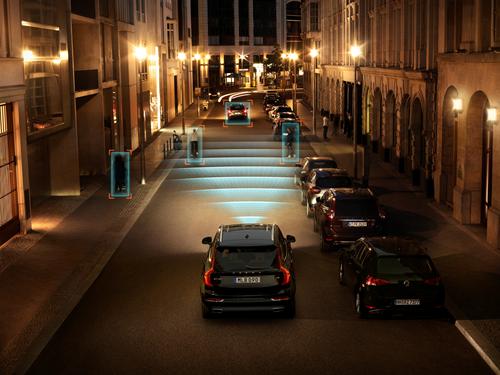 Starting with the all-new Volvo XC90, City Safety becomes the umbrella name for all of Volvo Cars’ auto brake functions. The continuously enhanced collision-avoidance and mitigation technologies, which are standard in the XC90, include yet another Volvo world first: automatic braking if the driver turns in front of an oncoming vehicle.
Starting with the all-new Volvo XC90, City Safety becomes the umbrella name for all of Volvo Cars’ auto brake functions. The continuously enhanced collision-avoidance and mitigation technologies, which are standard in the XC90, include yet another Volvo world first: automatic braking if the driver turns in front of an oncoming vehicle.
“City Safety is one of the most advanced standard crash prevention offers you can find in a modern car. It addresses vehicles, cyclists and pedestrians in certain situations, day and night,” explains Prof. Lotta Jakobsson, Senior Technical Specialist Safety at Volvo Cars Safety Centre.
As the leader in automotive safety, Volvo Cars has been pioneering auto brake technologies since the first-generation standard brake support was introduced in 2006. Among the groundbreaking technologies is the first-generation City Safety, which was introduced as a low-speed auto brake solution in 2008.
Now, City Safety takes on an extended, all-new role as the umbrella name for all Volvo Cars’ auto brake functions. The system is active at all speeds from 4 km/h (2.5 mph).
Auto brake at intersections – a world first
The auto brake at intersections is a world first that deals with a situation that is a common scenario at busy city crossings as well as highway crossings, where the speed limits are higher.
“Our studies of accident data from this accident type show that an important number of these crashes could have been avoided or mitigated if the turning vehicle had been equipped with auto brake. The solution is yet another example of how our new technologies target substantial real-life traffic problems. This strategy moves us closer and closer to our ambition that by 2020 no one should be killed or seriously injured in a new Volvo,” says Lotta Jakobsson.
City Safety auto braking functions
The purpose of the advanced crash avoidance system is to assist the driver through an intuitive warning strategy and a brake support system. If a collision is imminent, the system will provide automatic braking when the driver fails to respond to the imminent threat. The focus is on avoiding the collision entirely or reducing the car’s speed as much as possible prior to the impact. City Safety addresses:
• Oncoming vehicles, including motorcycles and cycles, when the driver turns left (or right in left-hand traffic). City Safety detects a potential crash and brakes automatically in order to avoid a collision or mitigate the consequences of a crash.
• Vehicles, including motorcycles, travelling in the same direction. City Safety is able to avoid a collision if the relative speed difference between the two vehicles is up to 50 km/h (31 mph). At higher speeds, the automatic braking helps to reduce the consequences of the collision.
• Cyclists crossing the path of the car or suddenly swerving out in front it. Depending on the situation, City Safety is able to avoid a collision if the relative speed difference is up to 45 km/h (28 mph). At higher speeds, the automatic braking can mitigate the consequences of the collision.
• Pedestrians walking out in front of the car. City Safety is able to avoid a collision at speeds up to 45 km/h (28 mph). At higher speeds, the automatic braking can help mitigate the consequences of the collision.
Detection also in darkness
City Safety is based on a combined camera and radar unit integrated at the top of the windscreen, in front of the interior rear-view mirror. The latest technology upgrade is a smarter and faster high-sensitive, megapixel image camera combined with advanced exposure control. This makes the detection and auto brake technology work effectively also when driving in darkness.
The radar’s task is to detect objects in front of the car and to determine their position and movement, and the distance to them. The camera identifies what type of object it is. The technology continuously monitors the object – and a central control unit uses the camera and radar data to evaluate the risk of a collision and to initiate the most efficient counteraction.
In an emergency situation, the driver receives an audible alert combined with a haptic warning in the shape of a short braking pulse and a light flashing on the lower part of the windscreen.
If the driver reacts to the warning and starts braking, the system is programmed to automatically ‘fill up’ with more braking power if necessary. If the driver does not react at all, the auto brake is activated. Full braking power is applied approximately 1.0 seconds before impact.
Avoiding real-life accidents
“Statistics show that about 90 percent of all accidents are caused by distracted drivers. Since City Safety remains alert even if the driver is distracted or tired, it helps to bring collision figures down considerably. We have, for instance, seen a documented reduction in frontal collisions in low-speed car-following situations by over 20 percent*,” says Lotta Jakobsson. She concludes: “Our aim is of course to continuously extend the City Safety auto brake technologies to cover more objects and traffic situations.”
*Source: If insurance company, Sweden, 2012
THE ALL-NEW VOLVO XC90 ADDRESSES DANGEROUS RUN-OFF ROAD CRASHES WITH WORLD-FIRST SOLUTION
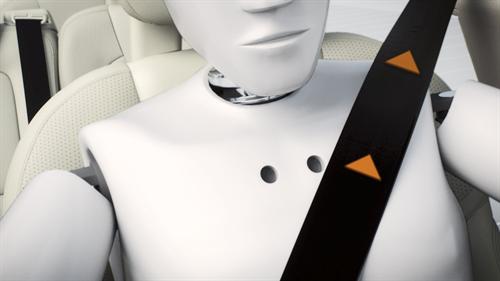

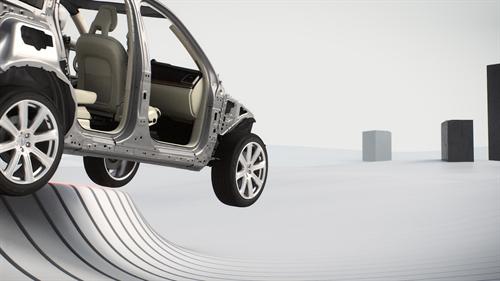 The standard safety package in the all-new Volvo XC90 includes a world-first run-off road protection package. Addressing these common and complex situations will take Volvo Cars another step closer to its vision that no one will be killed or seriously injured in a new Volvo car by 2020.
The standard safety package in the all-new Volvo XC90 includes a world-first run-off road protection package. Addressing these common and complex situations will take Volvo Cars another step closer to its vision that no one will be killed or seriously injured in a new Volvo car by 2020.
“Our solution focuses on keeping the occupants firmly in position and introducing unique ‘energy-absorbing’ functionality in the seat. This counteracts spine injuries, which are serious and relatively frequent consequences of run-off road scenarios,” says Prof. Lotta Jakobsson, Senior Technical Specialist Safety at Volvo Cars Safety Centre.
Run-off road is a common accident type with different causes, such as driver inattentiveness, fatigue or poor weather conditions. For example, half of all traffic fatalities in the United States are road departure crashes, while in Sweden, single-vehicle accidents involve one-third of all fatal and severe injury crashes with passenger cars.
Run-off road crashes are also very complex situations in which occupants often move in random directions – which puts high demands on the interior restraints.
Not covered by any rating programme
There are not yet any regulatory or rating tests to examine a car’s ability to handle run-off road crashes. “Committing to safety is not about passing a test or getting a ranking,” says Lotta Jakobsson. “It is about finding out how and why crashes and injuries occur and then developing the technology to prevent them. To reach our Vision 2020, we have to cover all accident types that occur in real-life traffic.”
Spine injuries common in run-off road scenarios
Injury trends in car accidents have changed over the years. A continuous development of car structure and implementation of different specialized safety systems have resulted in significant improvements in car safety over the past few decades. The risk of being seriously injured or killed in a new Volvo has been reduced by more than two-thirds compared with cars designed in the 1970s.
However, in contrast to this significant overall injury risk reduction, the frequency of thoracic and lumbar spine injuries has not been reduced to the same extent – and these injuries are overrepresented in run-off road scenarios, multiple impacts and multiple events.
“Studying our own extensive accident data, we discovered that the occupant’s posture during the load transfer through the spine is an important factor. In several of the cases, great occupant flexion was seen as an influencing factor. Anterior wedge fractures, resulting from a combination of axial load and flexion, are the most common spine injury in run-off road events together with compression fractures,” says Lotta Jakobsson.
Tightening belts and cushioning impact
The run-off road protection solution in the all-new XC90 includes two vital parts:
• Using input from the car’s advanced sensor system, the technology is able to detect a run-off road scenario. The front safety belts are electrically tightened as much as possible to retract and keep the occupants in position. The pulling capacity of the safety belt retractor is 1 mm/ms – which means it can retract 100 mm safety belt in only 0.1 seconds. The belts are firmly tightened as long as the car is in motion.
• To help prevent spine injuries, energy-absorbing functionality between the seat and seat frame deforms mechanically to cushion the vertical forces that can arise when the car encounters a hard landing in the terrain.
“By keeping the occupant in an upright posture while cushioning the impact, the vertical forces he or she is exposed to can be reduced by up to one-third. This helps to considerably lower the risk of the most serious and frequent spine injuries in these situations,” says Lotta Jakobsson.
Three complete vehicle test methods
Based on real-life data, Volvo Cars has developed three complete vehicle crash test track methods, called ‘Ditch’, ‘Airborne’ and ‘Rough terrain’, for evaluating the consequences of various run-off road scenarios.
During the ‘Airborne’ method the vehicle runs off the road at, e.g., 80 km/h. After the initial free flight, the car lands on a smooth surface and continues onwards. The height difference is 80 cm, resulting in a hard impact on the wheels. This causes massive vertical forces of the same level as a fighter pilot is subjected to when using his ejection seat in an emergency.
The ‘Ditch’ test is designed to replicate the bouncing movement when driving into an 80 cm deep ditch and impacting an embankment, which causes high vertical forces. The ‘Rough road’ test creates a bumpy ride in the terrain, producing substantial lateral rolling motions in combination with vertical and longitudinal vehicle motions.
Crash test dummies are used to represent humans in the tests. The most advanced dummy is ‘Thor’, which is equipped with an enhanced flexible shoulder area to create more human-like movement in a run-off road scenario.
Unique test rig
In addition to complete vehicle crash testing, Volvo Cars has also developed a flexible and multi-purpose test rig to evaluate occupant positioning and occupant retention. A vehicle seat and restraint system is mounted on a multi-axial industrial robot. The robot, which is used together with a crash test dummy, can be programmed to simulate the occupant kinematics in each of the three test track methods, or any other variation of a run-off road crash. (The robot is described in a separate press release.)
Helping the driver avoid run-off road scenarios
“Of course, we are also focusing on supporting the driver with technologies that help prevent run-off road crashes from happening. Two specific systems in the all-new XC90, Lane Keeping Aid and Driver Alert Control, are targeting these situations,” says Lotta Jakobsson.
Lane Keeping Aid helps the driver stay on track by applying extra steering torque if the car is about to leave the lane unintentionally. Driver Alert Control detects and warns tired or inattentive drivers. In the all-new XC90, it is enhanced with a new Rest Stop Guidance, which directs the driver to the nearest rest area.
THE ART OF TURNING AN AMUSEMENT PARK RIDE INTO A RUN-OFF ROAD TEST AT VOLVO CARS SAFETY CENTRE
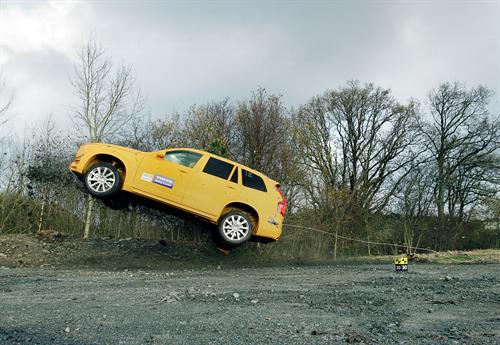 Volvo Cars’ safety expert Anders Axelson knows that brilliant ideas can pop up in the strangest of circumstances. A visit to Legoland with his twin daughters in 2007 inspired Anders to turn an amusement park ride into an efficient test method in Volvo Cars’ quest for better protection in run-off road crashes.
Volvo Cars’ safety expert Anders Axelson knows that brilliant ideas can pop up in the strangest of circumstances. A visit to Legoland with his twin daughters in 2007 inspired Anders to turn an amusement park ride into an efficient test method in Volvo Cars’ quest for better protection in run-off road crashes.
“Watching people being thrown in all directions during a ride in the ‘Robocoaster’, I suddenly realised that those rapid, random movements resembled the violent forces occupants in a run-off road crash are exposed to,” says Anders Axelson.
Run-off road crashes had been on Anders’ mind since 2006 when Volvo Cars intensified the development of technology to help protect car occupants in these common and complex scenarios.
Based on real-life accident data, Anders Axelson’s team initiated three complete vehicle crash test track methods, called ‘Ditch’, ‘Airborne’ and ‘Rough terrain’, for evaluating the consequences of various run-off road scenarios.
Analysing films from a large number of these tests confirmed that being thrown out of the ideal, firmly strapped-in seat position correlates well with potential injury-causing mechanisms seen in real-world crashes.
Searching for a test method
“The engineers developed promising solutions to actively retract the occupants in order to keep them in position. But since running complete cars into the terrain is a time-consuming and expensive test method, we needed a quicker and cheaper solution to evaluate the ideas,” Anders Axelson recalls.
The stroke of genius conveniently came on a family trip to Legoland in Denmark. At the time, Anders’s twin girls were too small for the ‘Robocoaster’, but after watching other kids being shaken by the robot arm, he realised that the ride had potential beyond making kids scream with joy.
Back at the office, Anders started searching for a similar robot that could be programmed to mimic the exact movement patterns that Volvo Cars had recorded during the complete vehicle run-off road crash tests.
Unique test rig
“The industrial robot manufacturer ABB had the technology and the knowledge to programme a machine designed for precision work to move a car seat around in a seemingly random pattern. It worked brilliantly,” says Anders Axelson.
A vehicle seat and restraint system is mounted on the multi-axial industrial robot. The robot, which is used together with a crash test dummy, can be programmed to simulate the occupant kinematics during crucial parts of run-off road scenarios.
During the development work of the all-new XC90 and upcoming cars based on the company’s new scalable architecture, Volvo Cars’ own ‘Robocoaster’ has been used to find the combination of safety belt geometry, rapid belt retraction and seat design that helps keep the occupant firmly in position in run-off road scenarios.
World-first run-off road safety solution
The result is a world-first run-off road protection package that includes rapid electrical safety belt retraction as well as unique ‘energy-absorbing’ functionality in the seat that cushions the vertical forces that occur in a ‘hard landing’ in the terrain.
“The most valuable result from the ‘Robocoaster’ tests is probably the insight into how well the safety belt retraction interacts with the enhanced side support in our new seat generation,” says Anders Axelson.
By the way, Anders Axelson never went on the ‘Robocoaster’ ride during that visit to Legoland. “No way. Violent rides like that make me sick,” he says with a smile.

You must be logged in to post a comment.